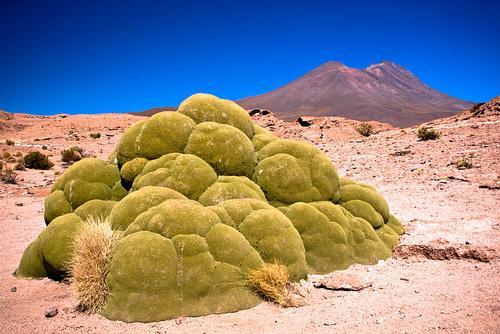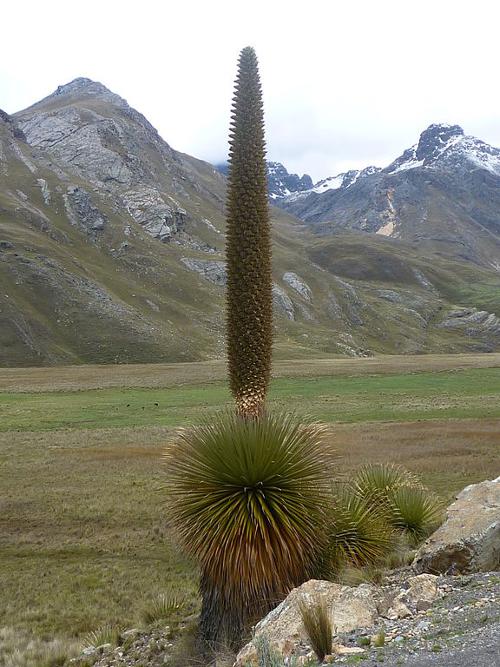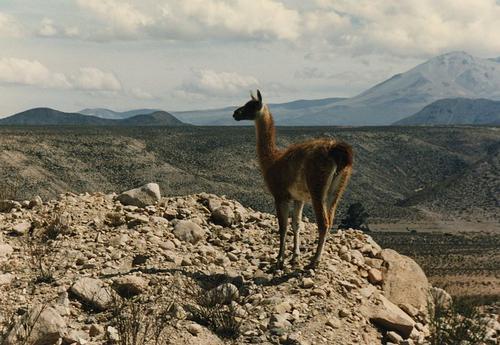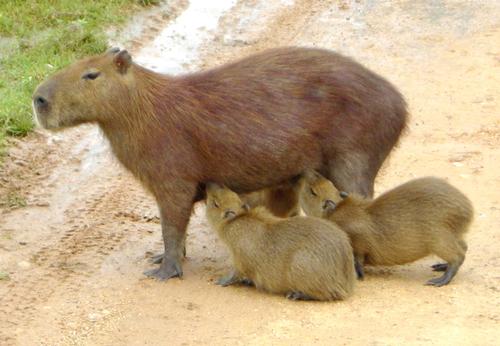BOLIVIA
Plants and Animals

Plants and Animals
Plants and Animals
Plants

The Amazon Plain in the northwest consists of tropical rainforest, as does the swampy area in the southeast. In the south, between the puna-páramo vegetation and the llano area, there is a region with Sierra vegetation, ie thorn bushes and cacti, and in higher parts evergreen forest. The Andean region has puna vegetation. The Ilano area has savanna vegetation, the plateau has partly páramo vegetation and partly puna vegetation.
The increasingly rare mahogany trees are still growing in the jungle. Furthermore cocoa and rubber trees, the bibosí and many palm species. The beautiful Victoria Regia is found in shallow lakes. Due to the cold and low rainfall, the Altiplano does not grow much: low shrubs, cacti, succulents, mosses and yellow grass pollen. A striking feature is the yareta, which grows above 4000 meters and can be hundreds of years old. The keñua is a tree species that can even survive up to 5200 meters.
 Puya Raimondi BoliviaPhoto: Vane 59 CC 3.0 Unported no changes made
Puya Raimondi BoliviaPhoto: Vane 59 CC 3.0 Unported no changes made
The Yungas (eastern mountain slopes) are largely covered with cloud forests and further ferns, mountain bamboo and eventually subtropical forest with orchids, bromeliads and palms. Many small trees and lianas grow under the gigantic trees of the tropical rainforest and on the bottom ferns, begonias and paradise flowers or heliconias.
The most special plant in Bolivia is the Puya Raimundi, the largest succulent plant in the world with a flower stem up to 12 meters in length. A hundred years pass before this plant flowers. The potato is the best known of the cultivated plants. More than 200 species occur in the Andes. Another plant that is important for food supply is yuca, which is grown in the lowlands. Maize and quinoa are also grown for food.
Animals

The most famous group of animals of the Andes mountains are the camelids: the guanaco, the vicuña, the alpaca and the llama. The guanaco and the vicuña live in the wild, the llama and the alpaca have been made pets. They are used as pack animals and for meat and wool. The vicuña is a protected animal and there are about 2000 specimens in Bolivia. Other unusual animals in the Andes Mountains include the fish cacha, a large chinchilla species with a remarkably long tail, the rare spectacled bear or Andean bear and the condor, a bird of prey with a wingspan of three meters that plays a major role in Bolivian mythology. Also the rhea, a rhea species (ostrich species), and the very rare James flamingo. Common waterfowl are Andean geese, ibises, avocets, grebes and coots. Hummingbirds and parrots can even be found above 4000 meters and mountain toucans also live at high altitudes.
Mammals in the Andes include the mountain ocelot and puma, the wild marmot and the armadillo. The tropical lowlands are home to many animals, including well-known animals such as the panther, the jaguar, the tapir, the javelí or umbilical pig and the anaconda, a huge strangling snake. Common monkey species are howler monkeys, spider monkeys and squirrel monkeys. Smaller mammals are coati, agoutis (rodent), anteaters, otters and sloths. In the pampa areas live in the rivers, among other things, water turtles, pink freshwater dolphins and alligators.
 Capibara BoliviaPhoto: Fidel León Darder CC 3.0 Unported no changes made
Capibara BoliviaPhoto: Fidel León Darder CC 3.0 Unported no changes made
The capybara is the largest rodent in the world. The large jabira is a stork-like and its colors make it a striking appearance. Furthermore, hoatzins, terns, cormorants, snake-necked birds and various types of kingfishers can be found in tropical Bolivia. Of the butterfly species, the large blue morpho is the most striking, next to beautiful passion flower and page butterflies. Salmon, trout and kingfish or pejerrey are found in Lake Titicaca. The avifauna is among the richest in the world. There are about 1200 species of birds; a curious short-winged grebe is only found near the mountain lakes Titicaca and Poopó.
Due to the tropical heartwood industry and the logging and burning for agriculture, many thousands of hectares of forest disappear every year. Only a small percentage has been reforested so far. The erosion and eventual desertification is a major threat to the plant and animal world. In recent years, the government has paid more attention to this. The national parks are difficult to reach, but could become a source of income because of tourism.
Sources
Bijl, Y. van der / Reishandboek Bolivia
Elmar
Lindert, P. van / Bolivia : mensen, politiek, economie, cultuur
Novib
Schimmel, K. / Bolivia
Chelsea House Publishers
Sprey, J. / Bolivia
Gottmer
Te gast in Bolivia
Informatie Verre Reizen
CIA - World Factbook
BBC - Country Profiles
Copyright: Team The World of Info